On the Bench
I measured the No 40 performance using an XLR input and output, in Stereo
mode, with no surround sound mode engaged, and no crossover adjustments.
It was tested into a load of 100 kOhms. THD+N measurements were within an 80 kHz bandwidth. There is no bypass mode,
so there was A/D and D/A involved in the signal path, at 24 bits and 96 kHz.
At 1 kHz, and 2 volts output, THD+N was a very
low 0.004%.
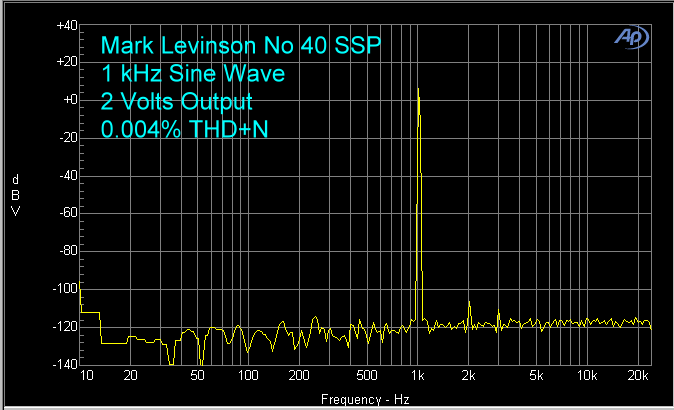
At 10 kHz, THD+N was the same as with a 1 kHz sine wave. Notice that, for 10
kHz, the third harmonic is larger than the second, while with the 1 kHz
test, the second harmonic is larger than the third. This is why it is
important to show the graphs rather than simply report a distortion number.
Even though the distortion number is the same for both tests - 0.004% - the
profile is different.
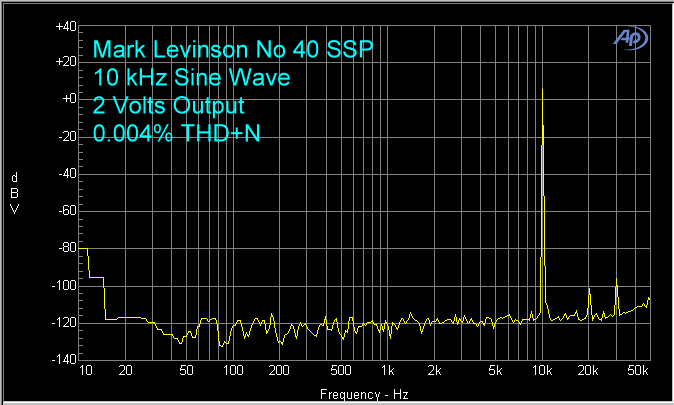
The SMPTE/DIN IMD test also showed very low
distortion at 2 volts output. You can see that there are only a few peaks
surrounding the 2 kHz fundamental, which is excellent. This translates to a
very detailed sound.
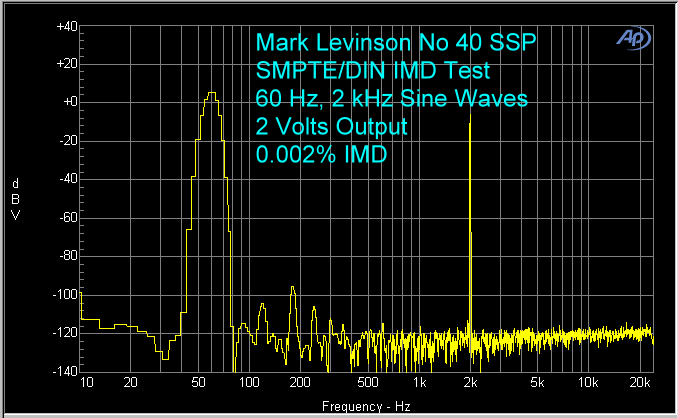
With 10 kHz and 11 kHz sine waves, the intermodulation peaks are few and
quite low.
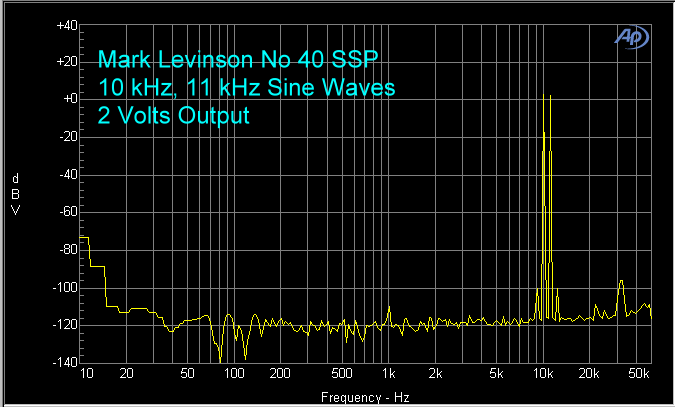
THD+N vs. Frequency indicates a flat
distortion picture in the audible band. This means a neutral sound,
which is indicative of very high performance. It also tells us that the No
40 will deliver the same output level in the upper frequencies before
clipping as it will at 1 kHz, which is the standard frequency for plotting
THD+N vs. Output (see second graph below).
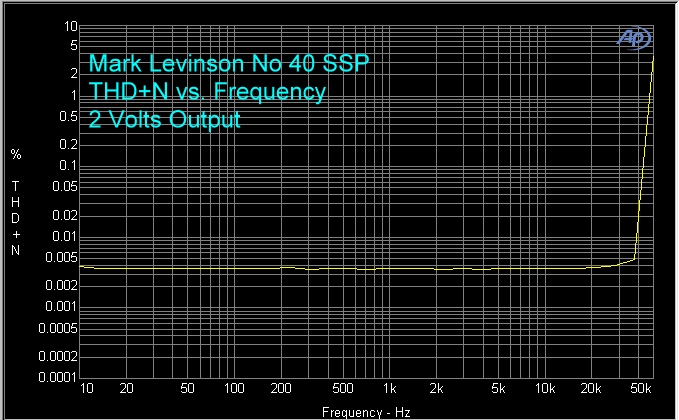
THD+N slopes downward beginning at 0.7% at 10
mV output, with a minimum of a little less than 0.002% at 4.2 volts output,
then rises to clip (1% THD+N) at 5 volts output. This was at the Ref
(Reference - 0 dB) volume setting. When I set the volume to Max, clipping
was at a little more than 7 volts.
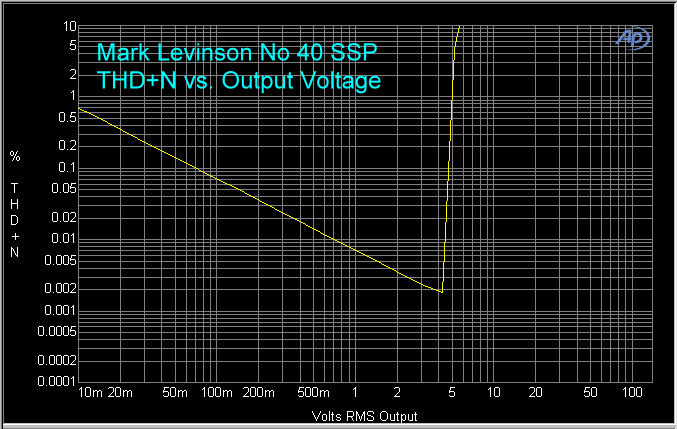
The frequency response was 10 Hz to 30 kHz, -
0.5 dB. The response drops off above 40 kHz due to the 24/96 A/D and D/A
that is in the signal path. The maximum analog frequency that can be handled
by 96 kHz digital sampling is 48 kHz.
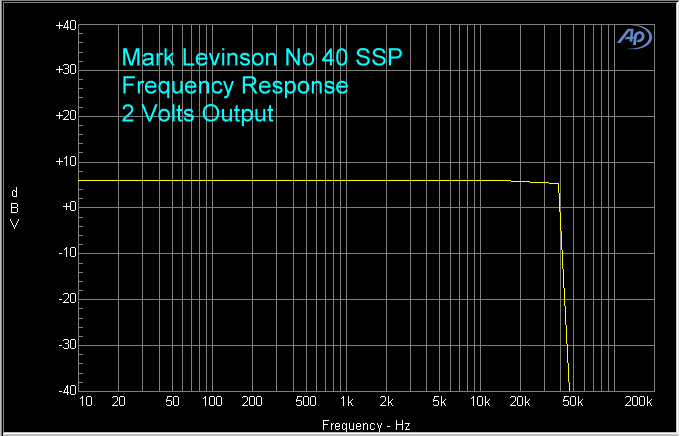
Conclusions
It is always reassuring to see that an
architecture which is touted for its modularity and expandability can prove
that when a need arises. The HDMI card offering has done just that. This is
particularly important since at present this is the only path over which to
realize the improvements offered by the next generation compression formats
being used by the next generation optical formats. The alternative would be
to either receive a multi-channel analog input from the playback device or
have the playback device re-encode the data and transmit a compliant
compressed bitstream. Neither option is appealing when you have an audio
section as good as what you get with the Mark Levinson No 40
Media Console.
While I am certainly pleased with the audio capabilities of the HDMI card, I
find its video capabilities lacking. There is no synergy between this card
and the video processor; they pretty much operate independently. None of the
inputs on the video processor or the OSD can be output over HDMI. I suspect
a
future update will address this concern.
The high cost of admission will certainly limit the market, but it is
perhaps a niche that ML wants to carve out for itself. This product will
certainly appeal to existing ML customers who want to move into the
multi-channel arena but still have a product which can excel in two-channel
music reproduction. I hope that ML considers offering a product at a lower
price point; maybe a single chassis solution which focuses more on the HDMI,
since this is the path we appear to be headed down. But if you cannot afford
this product, there are other competitive offerings to consider. The
wonderful sounding MC12B from sister company Lexicon is one such product, and
it offers Room EQ, something I would like to have seen here.
The No 40 is certainly a remarkable product. Its complexities are masked by
an extremely intuitive user interface which is a delight to use. A lot of
thought and care have gone into its design, and it shows. The companion
processors maintain the simple yet elegant look and feel of other products
with the Mark Levinson pedigree. The build-quality is outstanding. The part that is
most important, however, is its audio reproduction capability. Here the No 40
simply shines.
- Sumit Chawla -